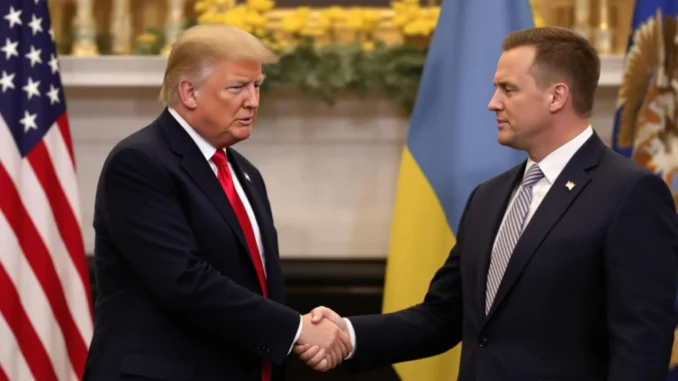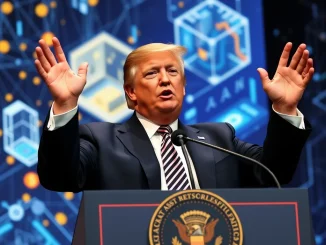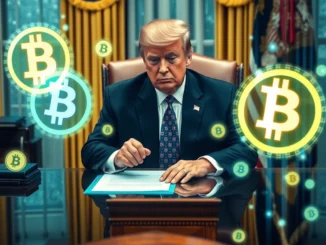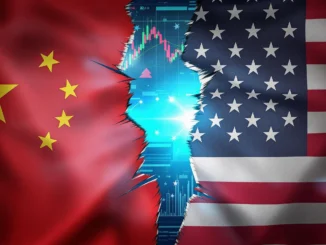
The ever-volatile landscape of international relations just witnessed another seismic shift as former U.S. President Donald Trump dropped a bombshell regarding the ongoing conflict involving Ukraine. In a recent statement on Truth Social, Trump claimed that Ukrainian President Volodymyr Zelensky is “not ready for peace,” despite a purported meeting between the two leaders at the White House. This shocking claim has sent ripples through political and cryptocurrency circles alike, raising urgent questions about the future of peace negotiations and the implications for global stability. Let’s delve into the details of this developing story.
Trump Zelensky Peace: A Meaningful Meeting or a Missed Opportunity?
According to Trump’s statement, he had a “meaningful meeting” with President Zelensky. While the specifics of this meeting remain shrouded in some mystery, Trump’s characterization of Zelensky’s disposition is far from conciliatory. He suggests that despite the United States’ significant intervention and support for Ukraine, which Trump believes gives Zelensky a “big advantage in negotiations,” the Ukrainian leader is still not prepared to engage in genuine peace talks. This assertion directly contradicts the widely held narrative of Ukraine actively seeking peace while defending its sovereignty against aggression.
Here’s a breakdown of Trump’s key points:
- Meaningful Meeting: Trump acknowledges a meeting with Zelensky at the White House.
- Zelensky Not Ready for Peace: The core claim is that Zelensky lacks the readiness for peace negotiations.
- US Advantage Ignored: Trump implies Zelensky is disregarding the leverage provided by U.S. support.
- Open to Return: Trump states Zelensky can “come back” when he is ready for peace, suggesting an open door for future dialogue, albeit on Trump’s terms.
Ukraine Peace Talks: Is Trump’s Assessment Accurate?
The question that immediately arises is: how accurate is Trump’s assessment? It’s crucial to consider this statement within the broader context of the Ukraine peace talks. While details from the alleged meeting are scarce, reports have surfaced indicating a potentially heated exchange between the two leaders. This alleged tension could be interpreted in various ways. Was it a frank and necessary exchange of perspectives, or a sign of deeper discord and irreconcilable differences in approach?
Several factors could contribute to Trump’s viewpoint:
| Possible Factors | Description |
|---|---|
| Differing Peace Visions | Trump and Zelensky might have fundamentally different ideas about what constitutes an acceptable peace agreement. |
| Negotiating Tactics | What Trump interprets as unreadiness could be Zelensky’s strategic approach to negotiations, aiming to secure the strongest possible position for Ukraine. |
| Political Messaging | Trump’s statement could be politically motivated, aimed at projecting an image of strength and decisiveness, or aligning with certain segments of his political base. |
| Information Gaps | Without full transparency on the meeting’s content, it’s challenging to definitively assess the validity of Trump’s claims. |
US Ukraine Relations: A Shifting Dynamic?
Trump’s statement also indirectly sheds light on the complex and evolving US Ukraine relations. The U.S. has been a staunch supporter of Ukraine, providing significant military and financial aid. Trump’s comment about Zelensky “ignoring the U.S.” hints at a potential frustration or perceived lack of deference from the Ukrainian side. This could signal a shift in the dynamic between the two nations, or simply be a reflection of Trump’s personal negotiating style and expectations.
Consider these points regarding the US-Ukraine relationship in light of Trump’s statement:
- Continued US Support: Despite Trump’s remarks, official U.S. policy remains supportive of Ukraine.
- Potential for Policy Shift: However, statements from influential figures like Trump can influence public opinion and potentially future policy directions, especially within certain political circles.
- Ukrainian Perspective: It’s vital to understand the Ukrainian perspective. Zelensky’s priorities are likely focused on protecting his nation’s sovereignty and securing a just and lasting peace, which might not perfectly align with external viewpoints.
Trump Ukraine Statement: Decoding the Message
To fully understand the implications of the Trump Ukraine statement, we need to decode its potential messages. Is this merely a negotiating tactic from Trump, aimed at pressuring Zelensky? Is it a genuine assessment of the current state of peace negotiations? Or is it a politically motivated statement with broader geopolitical implications?
Here are some possible interpretations:
- Pressure Tactic: Trump’s statement could be designed to publicly pressure Zelensky into adopting a more conciliatory stance in future peace talks.
- Genuine Frustration: It might reflect genuine frustration from Trump regarding the perceived pace or direction of peace efforts.
- Political Signaling: The statement could be aimed at signaling a potential shift in U.S. policy should Trump or a similar administration come to power in the future.
- Information Warfare: In the complex landscape of international conflict, statements like these can also be seen as part of broader information warfare, aimed at influencing public opinion and shaping the narrative.
Zelensky Negotiation Ready: What Does ‘Ready for Peace’ Really Mean?
Ultimately, the crux of Trump’s statement revolves around the question of whether Zelensky negotiation ready. But what does being “ready for peace” truly entail in such a complex and high-stakes conflict? Peace is not a binary state; it’s a process, often fraught with challenges and requiring nuanced approaches from all sides.
Readiness for peace can involve:
- Willingness to Negotiate: Being open to dialogue and engaging in good-faith negotiations.
- Realistic Expectations: Acknowledging the complexities of the situation and having realistic expectations about potential outcomes.
- Flexibility and Compromise: Being prepared to make compromises and find common ground.
- Focus on Long-Term Stability: Prioritizing a sustainable and lasting peace over short-term gains.
Whether Zelensky meets Trump’s definition of “ready for peace” is subjective and open to interpretation. It’s crucial to consider the immense pressure Zelensky is under, leading a nation at war and striving to protect its people and territory.
Conclusion: Navigating the Uncertain Path to Peace
Donald Trump’s assertion that Zelensky is “not ready for peace” injects a new layer of uncertainty into the already precarious situation in Ukraine. While the accuracy and motivations behind Trump’s statement remain open to debate, it underscores the complexities and challenges inherent in achieving peace in this conflict. The path forward requires careful diplomacy, a nuanced understanding of all perspectives, and a commitment from all parties to engage in meaningful dialogue. As the world watches, the hope remains that a path to lasting peace can be forged, despite the shocking pronouncements and ongoing geopolitical tensions. The cryptocurrency markets, sensitive to global events, will undoubtedly be monitoring these developments closely, as peace and stability are crucial for sustained economic and financial growth.



